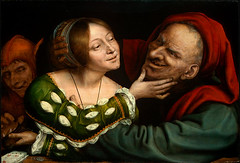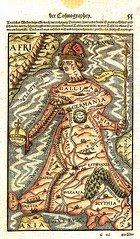Zygotic Acceleration, Biogenetic, De-Sublimated Libidinal Model (Enlarged x 1000) (1995) [1] is a sculpture by Jake and Dinos Chapman. It depicts lifesize fibreglass mannequins of children with genital organs of both sexes attached to their faces. It was shown at the Sensation exhibition in 1997, along with Great Deeds Against the Dead.
Sexual organs attached to faces is something I have been pondering on for as long as I can remember. What would have been the solution of the human race if this had been the case? How would we have covered the “pubic” area? How would lovemaking have looked like? This work by the Chapmans is remarkable, as is much of their other work. No doubt they are one of the most interesting contemporary artists.
In case you have been wondering why I only link to the pictures in this series, instead of showing the artworks in-line, the answer is that I keep a strict copyright policy after having had a run-in with my local copyright enforcement agency, SABAM, about two years ago. Since then, I only publish artworks by artists who have been dead for more than seventy years. Such is the law in Belgium. Belgian copyright law is even so strict that it prohibits to show photographs of buildings.
I find the use of mannequins in contemporary art very appealing, other works which have used this form are Chair, Table and Hat Stand by Allen Jones and Great Deeds Against the Dead, also by the Chapmans.
Previous entries in Icons of Erotic Art here, and in a Wiki format here.



